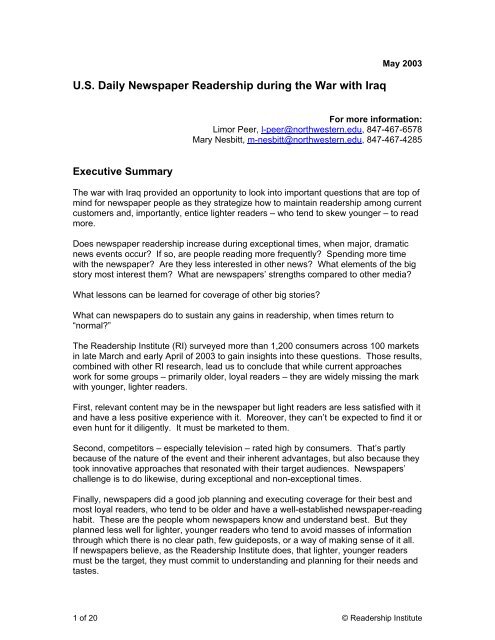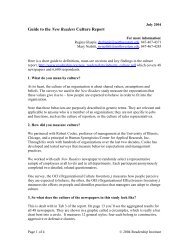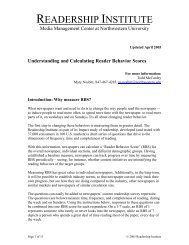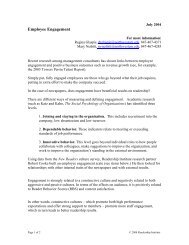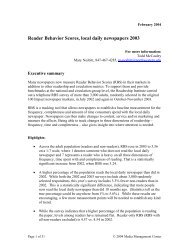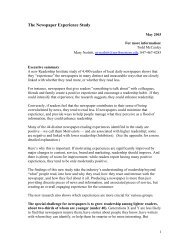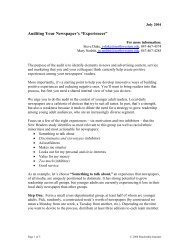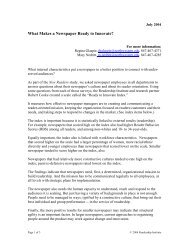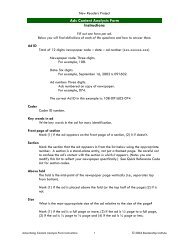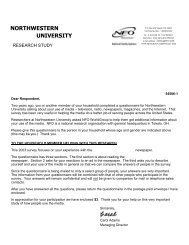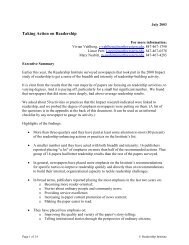U.S. Daily Newspaper Readership During the War with Iraq
U.S. Daily Newspaper Readership During the War with Iraq
U.S. Daily Newspaper Readership During the War with Iraq
You also want an ePaper? Increase the reach of your titles
YUMPU automatically turns print PDFs into web optimized ePapers that Google loves.
U.S. <strong>Daily</strong> <strong>Newspaper</strong> <strong>Readership</strong> during <strong>the</strong> <strong>War</strong> <strong>with</strong> <strong>Iraq</strong><br />
May 2003<br />
For more information:<br />
Limor Peer, l-peer@northwestern.edu, 847-467-6578<br />
Mary Nesbitt, m-nesbitt@northwestern.edu, 847-467-4285<br />
Executive Summary<br />
The war <strong>with</strong> <strong>Iraq</strong> provided an opportunity to look into important questions that are top of<br />
mind for newspaper people as <strong>the</strong>y strategize how to maintain readership among current<br />
customers and, importantly, entice lighter readers – who tend to skew younger – to read<br />
more.<br />
Does newspaper readership increase during exceptional times, when major, dramatic<br />
news events occur? If so, are people reading more frequently? Spending more time<br />
<strong>with</strong> <strong>the</strong> newspaper? Are <strong>the</strong>y less interested in o<strong>the</strong>r news? What elements of <strong>the</strong> big<br />
story most interest <strong>the</strong>m? What are newspapers’ strengths compared to o<strong>the</strong>r media?<br />
What lessons can be learned for coverage of o<strong>the</strong>r big stories?<br />
What can newspapers do to sustain any gains in readership, when times return to<br />
“normal?”<br />
The <strong>Readership</strong> Institute (RI) surveyed more than 1,200 consumers across 100 markets<br />
in late March and early April of 2003 to gain insights into <strong>the</strong>se questions. Those results,<br />
combined <strong>with</strong> o<strong>the</strong>r RI research, lead us to conclude that while current approaches<br />
work for some groups – primarily older, loyal readers – <strong>the</strong>y are widely missing <strong>the</strong> mark<br />
<strong>with</strong> younger, lighter readers.<br />
First, relevant content may be in <strong>the</strong> newspaper but light readers are less satisfied <strong>with</strong> it<br />
and have a less positive experience <strong>with</strong> it. Moreover, <strong>the</strong>y can’t be expected to find it or<br />
even hunt for it diligently. It must be marketed to <strong>the</strong>m.<br />
Second, competitors – especially television – rated high by consumers. That’s partly<br />
because of <strong>the</strong> nature of <strong>the</strong> event and <strong>the</strong>ir inherent advantages, but also because <strong>the</strong>y<br />
took innovative approaches that resonated <strong>with</strong> <strong>the</strong>ir target audiences. <strong>Newspaper</strong>s’<br />
challenge is to do likewise, during exceptional and non-exceptional times.<br />
Finally, newspapers did a good job planning and executing coverage for <strong>the</strong>ir best and<br />
most loyal readers, who tend to be older and have a well-established newspaper-reading<br />
habit. These are <strong>the</strong> people whom newspapers know and understand best. But <strong>the</strong>y<br />
planned less well for lighter, younger readers who tend to avoid masses of information<br />
through which <strong>the</strong>re is no clear path, few guideposts, or a way of making sense of it all.<br />
If newspapers believe, as <strong>the</strong> <strong>Readership</strong> Institute does, that lighter, younger readers<br />
must be <strong>the</strong> target, <strong>the</strong>y must commit to understanding and planning for <strong>the</strong>ir needs and<br />
tastes.<br />
1 of 20 © <strong>Readership</strong> Institute
Highlights of <strong>the</strong> war study findings:<br />
• This kind of event is an opportunity for newspapers to increase readership<br />
among desired groups – Reader Behavior Scores increased 5% for light readers<br />
after <strong>the</strong> war in <strong>Iraq</strong> began (though readership did not increase for heavier<br />
readers).<br />
• While riveting news events draw people to newspapers, <strong>the</strong> challenge is how to<br />
get <strong>the</strong>m to “stick.” Light readers were less satisfied and felt less positively about<br />
<strong>the</strong> newspaper than did medium and heavy readers, in terms of both coverage of<br />
<strong>the</strong> war and o<strong>the</strong>r non-war topics.<br />
• Interest in war news was very high. Most consumers (85%) said <strong>the</strong>y followed<br />
<strong>the</strong> news fairly or very closely. Men reported following <strong>the</strong> news about <strong>the</strong> war<br />
more intensely than women and older consumer more intensely than younger.<br />
• Usage was up across all media, particularly television. Nearly half of<br />
respondents (47.3%) said <strong>the</strong>y read <strong>the</strong> newspaper more closely.<br />
• All readers rated <strong>the</strong> war as <strong>the</strong> most important news during that period, but<br />
interest in o<strong>the</strong>r kinds of news remained robust. This indicates that at a time<br />
when resources and energy are focused on reporting and presenting a large and<br />
complicated news event, much attention still needs to be paid to o<strong>the</strong>r kinds of<br />
news and information.<br />
• Consumers were generally satisfied <strong>with</strong> newspapers’ coverage of <strong>the</strong> war and<br />
<strong>the</strong>y generally have positive feelings about <strong>the</strong> newspaper-reading experience –<br />
<strong>the</strong>y tended to agree that, for example, newspapers give a local perspective on<br />
<strong>the</strong> war or a context to better understand current events.<br />
• <strong>Newspaper</strong>s performed fairly well overall, but o<strong>the</strong>r media were perceived to be<br />
better. There are serious challenges for newspapers in dealing <strong>with</strong> competitors<br />
that have both natural advantages – like speed, immediacy, sound and video –<br />
and aggressive and creative approaches to making content and marketing it.<br />
• Television fared better than newspapers on most measures of consumers’<br />
perceptions, including those that newspapers think of as core competencies,<br />
such as most accurate, most expert and most complete.<br />
• The study provides details on <strong>the</strong> kinds of war-related coverage that interested<br />
readers in general, and different types of readers in particular. For instance, light<br />
readers would have been more satisfied <strong>with</strong> more content relating to personal<br />
safety (how to keep myself and my family safe at home, and how to keep safe<br />
while traveling); more explanatory visual information (maps, graphics and charts);<br />
and stories about longer-term implications (how post-war <strong>Iraq</strong> will be rebuilt and<br />
governed, how <strong>the</strong> war affects <strong>Iraq</strong>i citizens, <strong>the</strong> impact of <strong>the</strong> war on <strong>the</strong> stature<br />
of <strong>the</strong> U.S. in <strong>the</strong> world).<br />
The following sections explain <strong>the</strong> survey methodology and <strong>the</strong> findings in more detail.<br />
2 of 20 © <strong>Readership</strong> Institute
Background<br />
About <strong>the</strong> study<br />
1. Establishing a pre-war readership benchmark.<br />
One goal was to measure any changes in Reader Behavior Score (RBS) at two<br />
points in time: before <strong>the</strong> war in <strong>Iraq</strong> and once it began. RBS is a combined<br />
measure of three aspects of newspaper use frequency, time spent <strong>with</strong> it, and<br />
how much was read (see more at http://readership.org/consumers/rbs/main.htm).<br />
On March 3, 2003 a brief mail questionnaire was sent out to 15,000 random<br />
respondents in <strong>the</strong> 100 Impact markets, asking <strong>the</strong> basic RBS questions about<br />
readership of <strong>the</strong> local daily newspaper. We received 1,552 completed surveys<br />
(10% response rate, which is typical for mail surveys). Data was weighted to<br />
census figures.<br />
2. Establishing in-war readership levels, media use, and reactions to newspapers’ war<br />
coverage and media.<br />
On March 24 and 25, 2003 a 4-page mail questionnaire was sent out to <strong>the</strong> 1,552<br />
respondents from <strong>the</strong> pre-war study and to a random sample of 3,448 who did<br />
not respond from <strong>the</strong> original 15,000 contacted, for a total of 5,000. We received<br />
1,244 completed surveys (25% response rate). Data were weighted to census<br />
figures<br />
This survey asked <strong>the</strong> same panel of RBS questions, plus questions about<br />
general media use and about consumers’ interest in and satisfaction <strong>with</strong> <strong>the</strong>ir<br />
local daily newspaper’s coverage of <strong>the</strong> war. Ano<strong>the</strong>r goal of <strong>the</strong> study was to<br />
get more information about consumers’ general media use during <strong>the</strong> war in <strong>Iraq</strong>,<br />
beyond <strong>the</strong>ir newspaper reading behavior. For example, consumers rated <strong>the</strong><br />
content of <strong>the</strong> newspaper and rated newspapers in comparison <strong>with</strong> television,<br />
radio and <strong>the</strong> Internet (see both pre-war and war coverage questionnaires at<br />
http://readership.org/consumers/<strong>War</strong>Survey.htm).<br />
Analysis<br />
A total of 746 respondents returned both <strong>the</strong> pre-war and in-war surveys. We were able<br />
to compute and compare RBS for both points in time.<br />
All o<strong>the</strong>r information in addition to RBS – i.e., interest in <strong>the</strong> war, media usage, content<br />
preferences, reading experiences – is extracted from <strong>the</strong> in-war study <strong>with</strong> all 1,244<br />
consumers. One-way analysis of variance was used to compare means, accepting<br />
values of p
Findings<br />
What happened to readership?<br />
Looking at <strong>the</strong> same group of people (746 respondents) before and during <strong>the</strong> war,<br />
overall readership did not change. But it did change by sub-group – light readers read<br />
more, medium readers read about <strong>the</strong> same, and heavy readers read less. 1<br />
RBS<br />
Overall Light Medium Heavy<br />
Pre-war 4.25 2.05 4.81 5.87<br />
In-war 4.25 2.32 4.76 5.66<br />
Change 0.00 0.27** -0.05<br />
Base: 746; 1-7 scale<br />
-0.21**<br />
** Significant at 95% level of confidence (p < .001)<br />
To <strong>the</strong> extent that readers changed behavior after <strong>the</strong> beginning of <strong>the</strong> war in <strong>Iraq</strong>, <strong>the</strong>y<br />
did so selectively. Overall, <strong>the</strong>y tended to spend more time <strong>with</strong> <strong>the</strong> newspaper,<br />
especially on Sunday, but not necessarily read it more often or more thoroughly. Light<br />
readers, however, increased frequency and completeness as well as time spent <strong>with</strong><br />
newspapers after <strong>the</strong> beginning of <strong>the</strong> war in <strong>Iraq</strong>. Medium readers’ RBS stayed about<br />
<strong>the</strong> same – <strong>the</strong>y spent more time <strong>with</strong> <strong>the</strong> paper, but read less frequently and less<br />
completely. Heavy readers read less – time spent stayed about <strong>the</strong> same (or increased<br />
on Sundays), but <strong>the</strong>y read less often and less completely.<br />
Change in RBS components<br />
Overall Light Medium Heavy<br />
Weekday freqency 0.05 0.38** -0.10* -0.11*<br />
Sunday frequency 0.01 0.45** -0.14* -0.27**<br />
Weekday time 0.06 0.15* 0.11* -0.02<br />
Sunday time 0.15* 0.14* 0.21** 0.11*<br />
Weekday completeness -0.11* 0.36** -0.13* -0.45**<br />
Sunday completeness -0.12* 0.28** -0.26** -0.40**<br />
Reader Behavior Score 0.00 0.27** -0.05<br />
Base: 746; 1-7 scale<br />
-0.21**<br />
* Significant at 95% level of confidence (p < .005)<br />
** Significant at 95% level of confidence (p < .001)<br />
It’s important to note that light readers were not only picking up <strong>the</strong> paper more often,<br />
<strong>the</strong>y were also looking into more parts of it. <strong>War</strong> coverage brought <strong>the</strong>m to <strong>the</strong><br />
newspaper and, while <strong>the</strong>re, <strong>the</strong>y looked into different parts of it. Was it enough to make<br />
<strong>the</strong>m stay? We discuss this question below.<br />
1 RBS scores range from 1-7. In this study, consumers identified as light readers scored from<br />
1.00-3.57, medium readers scored 3.60-5.19, and heavy readers scored 5.22-7.00.<br />
4 of 20 © <strong>Readership</strong> Institute
Attention to news about <strong>the</strong> war in <strong>Iraq</strong><br />
Interest in <strong>the</strong> war was very high: 85% said <strong>the</strong>y followed <strong>the</strong> news fairly or very closely<br />
since <strong>the</strong> war began.<br />
Not all readers reported <strong>the</strong> same level of interest, however. Heavier readers’ interest<br />
was higher than light readers’, men’s higher than women’s and older readers’ higher<br />
than younger readers’.<br />
Follow <strong>the</strong> news about <strong>the</strong> war…<br />
RBS Age Gender<br />
% Overall Light Medium Heavy 60 Male Female<br />
Very closely 36.90 29.40 35.26 45.78 33.74 33.44 47.10 41.52 32.55<br />
Fairly closely 48.00 49.73 48.61 45.78 46.34 50.41 44.03 44.95 50.93<br />
Not too closely 11.70 16.76 10.83 7.67 13.41 13.70 6.14 11.19 12.14<br />
Not at all 3.40 4.12 5.29 0.77 6.50 2.45 2.73 2.35 4.38<br />
Base: 1244<br />
Consumers also reported that <strong>the</strong>y were used all media more closely, or more<br />
attentively. Nearly half (47.3%) said <strong>the</strong>y read <strong>the</strong> newspaper more closely. Almost<br />
80% said <strong>the</strong>y watched television more closely.<br />
Read/watch/listen/visit more closely…<br />
RBS Age Gender<br />
% Overall Light Medium Heavy 60 Men Women<br />
<strong>Newspaper</strong>s… 47.3 26.1 52.3 63.2 36.5 45.0 60.8 47.7 46.9<br />
Television… 79.7 73.6 79.1 86.4 21.5 52.5 26.0 76.7 82.5<br />
Radio… 44.1 40.9 47.0 44.4 19.2 61.1 19.7 50.3 38.5<br />
Web sites… 23.5 27.8 24.3 18.3 28.0 59.1 12.9 27.9 19.4<br />
Magazines… 15.7 10.1 18.2 19.3 13.5 14.3 21.3 16.9 14.7<br />
Base: 1244<br />
While many light readers used all media more closely, a larger number of medium and<br />
heavy readers reported using television, newspaper, radio and news magazines more<br />
closely. Relatively more light readers, however, reported an increase in Internet use.<br />
O<strong>the</strong>r interesting differences among groups relate to age. Increased use of newspapers<br />
and news magazines can be predicted by age – older consumers are more likely to<br />
report reading <strong>the</strong>m more closely. We see a different pattern <strong>with</strong> television, radio and<br />
<strong>the</strong> Internet – a much larger number of 35-59 year olds reported using <strong>the</strong>se media than<br />
consumers in younger or older age groups.<br />
More women reported watching television more closely than did men, whereas more<br />
men reported listening to <strong>the</strong> radio more closely and visiting more web sites.<br />
5 of 20 © <strong>Readership</strong> Institute
Types of <strong>War</strong> Coverage<br />
Consumers rated 21 war-related content areas in terms of how important that type of<br />
coverage was to <strong>the</strong>m and how satisfied <strong>the</strong>y were <strong>with</strong> <strong>the</strong>ir local daily newspaper’s<br />
coverage. Using factor analysis we collapsed <strong>the</strong>se into seven broad categories. In<br />
addition, consumers rated eight types of specific war-related information that offers<br />
people practical steps and actions to take, and that we shorthand as “go-and-do”<br />
information. All factors registered a high coefficient alpha (α), which means inter-item<br />
consistency was high.<br />
This kind of analysis gives insight into how consumers think about news, as opposed to<br />
how news- producers think about it. The categories are <strong>the</strong> general kinds of coverage<br />
that interest readers. They are a conceptual checklist when planning and executing<br />
coverage of future, large news events that matter to readers.<br />
Core news and analysis (α=.8582)<br />
Basic event and “what it means” coverage:<br />
• Accounts of military action in <strong>Iraq</strong><br />
• Analysis and commentary about <strong>the</strong> war in <strong>Iraq</strong><br />
Me and my community (α=.8633)<br />
The impact on me, my community and average Americans:<br />
• How <strong>the</strong> war affects my life and my community<br />
• How <strong>the</strong> war affects <strong>the</strong> average person in <strong>the</strong> U.S.<br />
Official activity (α=.8753)<br />
How officials here and abroad are reacting to events:<br />
• What government officials in o<strong>the</strong>r countries are doing or saying about <strong>the</strong><br />
war in <strong>Iraq</strong><br />
• What U.S. government officials are doing or saying about <strong>the</strong> war in <strong>Iraq</strong><br />
Readers’ opinions (α=1.000)<br />
• Information and perspectives from o<strong>the</strong>r readers (e.g., letters)<br />
Tell a compelling story (α=.8853)<br />
Using photos, info-graphics and <strong>the</strong> stories of ordinary service-people to help<br />
readers connect <strong>with</strong> events:<br />
• Personal stories about U.S. military men and women and <strong>the</strong>ir role in <strong>the</strong> war<br />
• Photos showing what is happening and who is involved<br />
• Visual information that helps explain what is happening (maps, graphics,<br />
charts)<br />
6 of 20 © <strong>Readership</strong> Institute
Long-term implications (α=.9368)<br />
Looking past immediate events to <strong>the</strong> long-term prospects for U.S. security and<br />
stature and o<strong>the</strong>r global issues:<br />
• Information about <strong>the</strong> impact of <strong>the</strong> war on U.S. and global economy<br />
• Information about threats to U.S. civilians<br />
• How <strong>the</strong> war could affect <strong>the</strong> next U.S. presidential elections in 2004<br />
• Information about <strong>the</strong> impact of <strong>the</strong> war on <strong>the</strong> stature of <strong>the</strong> U.S. in <strong>the</strong> world<br />
and its relations <strong>with</strong> o<strong>the</strong>r countries and <strong>the</strong> U.N.<br />
• Information about relief and humanitarian efforts<br />
• Information about <strong>the</strong> impact of <strong>the</strong> war on natural resources and <strong>the</strong><br />
environment<br />
Context and background (α=.9270)<br />
Background facts about <strong>the</strong> conflict that help in getting a deeper understanding:<br />
• How post-war <strong>Iraq</strong> will be rebuilt and governed<br />
• How <strong>the</strong> war affects <strong>Iraq</strong>i civilians<br />
• General information about <strong>Iraq</strong> and <strong>the</strong> region<br />
• How ordinary people in o<strong>the</strong>r countries are reacting to U.S. actions<br />
• How <strong>the</strong> media cover <strong>the</strong> war<br />
Go-and-do information (α=.9483)<br />
How individuals can take a variety of actions:<br />
• How I can contribute to a pro- or anti-war effort<br />
• How I can help <strong>with</strong> relief and humanitarian efforts for victims of war<br />
• How I can support U.S. service people and <strong>the</strong>ir families<br />
• How to keep myself and my family safe at home<br />
• How to keep safe while traveling<br />
• What to do in case of emergency<br />
• Where I can go to find more information<br />
• Who I can contact to make my opinion heard<br />
7 of 20 © <strong>Readership</strong> Institute
Overall reader satisfaction <strong>with</strong> newspaper war coverage<br />
All war-related content was fairly important to consumers, <strong>with</strong> an average rating of 2.18<br />
(on a 1-3 scale). Consumers were also generally satisfied <strong>with</strong> how <strong>the</strong> newspaper<br />
covered war-related content, <strong>with</strong> an average rating of 3.16 (on a 1-5 scale).<br />
We compared levels of importance and satisfaction for each content area, and <strong>the</strong>n<br />
categorized each as high or low on both importance and satisfaction, based on <strong>the</strong><br />
median score (i.e., above <strong>the</strong> median score is high and below is low). Each content area<br />
could <strong>the</strong>n be placed in a quadrant and characterized for future action in one of four<br />
ways:<br />
Keep it up: <strong>the</strong> subject is of high importance to readers and <strong>the</strong>ir satisfaction <strong>with</strong> <strong>the</strong><br />
newspaper’s performance is high as well. The newspaper should continue to pay a lot of<br />
attention to this kind of coverage.<br />
Doing enough: <strong>the</strong> subject is of low importance to readers and <strong>the</strong>y are satisfied <strong>with</strong><br />
<strong>the</strong> newspaper’s performance. Doing more, or better, will probably not bring enough<br />
benefits to make it worth <strong>the</strong> effort.<br />
Needs attention: <strong>the</strong> subject is of high importance but satisfaction among readers is<br />
low. The newspaper must work to significantly improve its performance.<br />
Low priority: <strong>the</strong> subject is of low importance and satisfaction is low as well. In terms of<br />
priorities, this can drop to <strong>the</strong> bottom.<br />
Satisfaction<br />
High<br />
Low<br />
High Keep it up Needs attention<br />
Importance<br />
Low Doing enough Low priority<br />
Looking at <strong>the</strong> results for readers generally, newspapers did fairly well in <strong>the</strong>ir coverage<br />
of aspects of <strong>the</strong> war consumers felt were important.<br />
8 of 20 © <strong>Readership</strong> Institute
• About one-third of content areas (11 of 29) fall into <strong>the</strong> “keep it up” category,<br />
which means that consumers placed high importance on <strong>the</strong>se content areas and<br />
were satisfied <strong>with</strong> coverage.<br />
• Five are in <strong>the</strong> “needs attention” category, which means that consumers place<br />
high importance on <strong>the</strong>se areas, but are not satisfied <strong>with</strong> <strong>the</strong>ir coverage.<br />
• Four are in <strong>the</strong> “doing enough” category, which means consumers are satisfied<br />
<strong>with</strong> <strong>the</strong>se, but do not think <strong>the</strong>y are terribly important.<br />
• Nine are in <strong>the</strong> “low priority” category, which means that consumers are not very<br />
satisfied, but <strong>the</strong>y also don’t see <strong>the</strong>se as very important.<br />
Go-and-do<br />
‣ How to keep safe while traveling<br />
Context and background<br />
‣ How post-war <strong>Iraq</strong> will be rebuilt and<br />
governed<br />
Long-term implications<br />
‣ Information about relief and<br />
humanitarian efforts<br />
Needs attention<br />
‣ Information about <strong>the</strong> impact of <strong>the</strong><br />
war on U.S. and global economy<br />
Me & my community<br />
‣ How <strong>the</strong> war affects <strong>the</strong> average<br />
person in <strong>the</strong> U.S.<br />
Me & my community<br />
‣ How <strong>the</strong> war affects my life and my<br />
community<br />
Official activity<br />
‣ What U.S. government officials are<br />
doing or saying about <strong>the</strong> war in <strong>Iraq</strong><br />
Tell a compelling story<br />
‣ Personal stories about U.S. military<br />
men and women and <strong>the</strong>ir role in <strong>the</strong><br />
war<br />
‣ Photos showing what is happening<br />
and who is involved<br />
‣ Visual information that helps explain<br />
what is happening (maps, graphics,<br />
charts) Substance<br />
Keep it up<br />
Core news and analysis<br />
‣ Accounts of military action in <strong>Iraq</strong><br />
Long-term implications<br />
‣ Information about threats to U.S.<br />
civilians<br />
‣ Information about <strong>the</strong> impact of <strong>the</strong><br />
war on <strong>the</strong> stature of <strong>the</strong> U.S. in <strong>the</strong><br />
world and its relations <strong>with</strong> o<strong>the</strong>r<br />
countries and <strong>the</strong> U.N.<br />
Go-and-do<br />
‣ How I can support U.S. service<br />
people and <strong>the</strong>ir families<br />
‣ What to do in case of emergency<br />
‣ How to keep myself and my family<br />
safe at home<br />
Go-and-do<br />
‣ Who I can contact to make my<br />
opinion heard<br />
Core news and analysis<br />
‣ Analysis and commentary about <strong>the</strong><br />
war in <strong>Iraq</strong><br />
Doing enough<br />
Context and background<br />
‣ How <strong>the</strong> media cover <strong>the</strong> war<br />
Readers’ opinions<br />
‣ Information and perspectives from<br />
o<strong>the</strong>r readers (e.g., letters)<br />
9 of 20 © <strong>Readership</strong> Institute
Go-and-do<br />
‣ Where I can go to find more<br />
information<br />
‣ How I can contribute to a pro- or<br />
anti-war effort<br />
‣ How I can help <strong>with</strong> relief and<br />
humanitarian efforts for victims of<br />
war<br />
Official activity<br />
‣ What government officials in o<strong>the</strong>r<br />
countries are doing or saying about<br />
<strong>the</strong> war in <strong>Iraq</strong><br />
Low priority<br />
Context and background<br />
‣ How ordinary people in o<strong>the</strong>r<br />
countries are reacting to U.S.<br />
actions<br />
‣ General information about <strong>Iraq</strong> and<br />
<strong>the</strong> region<br />
‣ How <strong>the</strong> war affects <strong>Iraq</strong>i civilians<br />
Long-term implications<br />
‣ How <strong>the</strong> war could affect <strong>the</strong> next<br />
U.S. presidential elections in 2004<br />
‣ Information about <strong>the</strong> impact of <strong>the</strong><br />
war on natural resources and <strong>the</strong><br />
environment<br />
Satisfaction <strong>with</strong> war coverage among different groups<br />
It is important to note <strong>the</strong> differences among reader groups.<br />
There is agreement on eleven of <strong>the</strong> 29 content areas, and <strong>the</strong> remaining 18 are rated<br />
differently by groups of readers (see Appendix A).<br />
Light readers populate all four quadrants about equally – <strong>the</strong>y are not more or less<br />
inclined to feel <strong>the</strong>re are very important topics that are not being covered to <strong>the</strong>ir<br />
satisfaction than <strong>the</strong>re are unimportant topics <strong>with</strong> which <strong>the</strong>y are satisfied.<br />
But, light readers are more likely than heavier readers to fall into <strong>the</strong> “needs attention”<br />
category.<br />
Specifically, more attention to <strong>the</strong>se areas of coverage would have benefited light<br />
readers:<br />
• How to keep myself and my family safe at home<br />
• How to keep safe while traveling<br />
• Visual information (e.g. maps, graphics, charts)<br />
• How post-war <strong>Iraq</strong> will be rebuilt and governed<br />
• How war affects <strong>Iraq</strong>i civilians<br />
• The impact of <strong>the</strong> war on <strong>the</strong> status of <strong>the</strong> U.S, in <strong>the</strong> world<br />
• Information about threats to U.S. civilians<br />
Medium and heavy readers tend to fall into two categories, “keep it up” and “low priority,”<br />
suggesting that heavier readers tended to be satisfied <strong>with</strong> coverage of topics <strong>the</strong>y feel<br />
are important and less satisfied <strong>with</strong> topics <strong>the</strong>y feel are less important.<br />
This implies that lighter readers have a unique set of priorities and standards.<br />
For example, light readers are not satisfied <strong>with</strong> visual information in <strong>the</strong> newspaper, but<br />
medium and heavy readers are. All three groups, however, rate it as important. Ano<strong>the</strong>r<br />
example is how <strong>the</strong> war affects <strong>Iraq</strong>i civilians. For light readers this is an important topic,<br />
but for medium and heavy readers it is not. Light readers are not satisfied <strong>with</strong> <strong>the</strong><br />
10 of 20 © <strong>Readership</strong> Institute
coverage, and nei<strong>the</strong>r are medium readers. Heavy readers, on <strong>the</strong> o<strong>the</strong>r hand, are<br />
satisfied. In terms of action around this topic, by doing a better job covering how <strong>the</strong> war<br />
affects <strong>Iraq</strong>i civilians, newspapers could have increased satisfaction among light readers<br />
<strong>with</strong>out alienating heavier readers.<br />
Awareness of <strong>War</strong> Coverage<br />
A substantial proportion of readers reported <strong>the</strong>y did not see certain war-related content<br />
areas in <strong>the</strong> newspaper at all (Note: <strong>the</strong> above satisfaction ratings include only those<br />
who said <strong>the</strong>y say saw <strong>the</strong> coverage).<br />
Percent who<br />
said <strong>the</strong>y<br />
“did not see”<br />
<strong>War</strong>-related content<br />
content*<br />
Accounts of military action in <strong>Iraq</strong> 6.7<br />
Analysis and commentary about <strong>the</strong> war in <strong>Iraq</strong> 9.2<br />
General information about <strong>Iraq</strong> and <strong>the</strong> region 10.1<br />
How ordinary people in o<strong>the</strong>r countries are reacting to U.S. actions 11.3<br />
How post-war <strong>Iraq</strong> will be rebuilt and governed 17.6<br />
How <strong>the</strong> media cover <strong>the</strong> war 12.2<br />
How <strong>the</strong> war affects <strong>Iraq</strong>i civilians 11.4<br />
How <strong>the</strong> war affects my life and my community 9.6<br />
How <strong>the</strong> war affects <strong>the</strong> average person in <strong>the</strong> United States 11.7<br />
How <strong>the</strong> war could affect <strong>the</strong> next U.S presidential election in 2004 22.9<br />
Information about relief and humanitarian efforts 9.6<br />
The impact of war on natural resources & <strong>the</strong> environment 16.7<br />
The impact of war on <strong>the</strong> stature of <strong>the</strong> U.S. in <strong>the</strong> world 11.0<br />
The impact of <strong>the</strong> war on U.S. and global economy 11.2<br />
Information about threats to U.S. civilians 12.3<br />
Information and perspectives from o<strong>the</strong>r readers 13.7<br />
Personal stories about U.S. military men and women 10.0<br />
Photos showing what is happening and who is involved 6.6<br />
Visual information (e.g., maps, graphics, charts) 8.6<br />
Government officials in o<strong>the</strong>r countries on <strong>the</strong> war in <strong>Iraq</strong> 9.1<br />
U.S. government officials on <strong>the</strong> war in <strong>Iraq</strong> 6.8<br />
How I can contribute to a pro- or anti-war effort 38.5<br />
How I can help <strong>with</strong> relief and humanitarian efforts for victims of war 30.0<br />
How I can support U.S. service people and <strong>the</strong>ir families 17.6<br />
How to keep myself and my family safe at home 17.9<br />
How to keep safe while traveling 20.5<br />
What to do in case of emergency 20.1<br />
Where I can go to find more information 30.0<br />
Who I can contact to make my opinion heard 28.8<br />
*Percent of readers only (n=974; non-readers were excluded from <strong>the</strong> sample)<br />
11 of 20 © <strong>Readership</strong> Institute
This finding helps shed light on <strong>the</strong> previous analysis of importance and satisfaction.<br />
The fact that, for example, almost 18% of readers did not see any content about “how<br />
post-war <strong>Iraq</strong> will be rebuilt and governed,” brings urgency to <strong>the</strong> finding that most<br />
consumers rate it as important but its coverage is not satisfactory. On <strong>the</strong> o<strong>the</strong>r hand,<br />
“How I can contribute to a pro- or anti-war effort” was not seen by almost 40% of<br />
consumers, but it is rated low on both importance and satisfaction.<br />
In terms of actionable steps, this has implications for content presentation and<br />
promotion. The fact that some did not see much of <strong>the</strong> content suggests that<br />
newspapers not only need to include coverage of content consumers see as important<br />
(and do a better job <strong>with</strong> it if <strong>the</strong>y are not satisfied), but also pay attention to how <strong>the</strong>y<br />
present and promote it.<br />
The newspaper-reading experience during <strong>the</strong> war<br />
Consumers were asked to rate 21 statements about <strong>the</strong>ir feelings about <strong>the</strong> newspaper<br />
or <strong>the</strong>ir experience reading it during <strong>the</strong> war in <strong>Iraq</strong>. The statements ranged from why<br />
<strong>the</strong>y read <strong>the</strong> paper to what <strong>the</strong>y get out of <strong>the</strong> paper to what it is like for <strong>the</strong>m to read<br />
<strong>the</strong> paper.<br />
Generally, consumers report having a mildly positive experience <strong>with</strong> <strong>the</strong> paper. The<br />
average score is 3.24 on a 1-5 scale.<br />
The mid-point of <strong>the</strong> scale is neutral (“I nei<strong>the</strong>r agree nor disagree”) and anything above<br />
3 is considered to be in agreement <strong>with</strong> <strong>the</strong> experience; <strong>the</strong> higher <strong>the</strong> number <strong>the</strong><br />
stronger <strong>the</strong> agreement. The same is true in <strong>the</strong> o<strong>the</strong>r direction – <strong>the</strong> lower <strong>the</strong> number<br />
<strong>the</strong> stronger <strong>the</strong> disagreement. For example, consumers fairly strongly agree that<br />
newspapers let <strong>the</strong>m control how much information <strong>the</strong>y take in and when. They also<br />
agree, though less strongly, that newspapers give <strong>the</strong>m context to better understand<br />
current events. Finally, <strong>the</strong>y pretty much disagree that newspapers use more expert<br />
sources than television does.<br />
There are significant differences in some newspaper reading experiences across<br />
groups. Lighter and younger readers consistently rated <strong>the</strong> experiences lower. For<br />
example, <strong>the</strong> rating of <strong>the</strong> statement “newspapers report on what I care about” increases<br />
<strong>with</strong> RBS levels (i.e., light readers gave it a lower rating than heavier readers) as well as<br />
<strong>with</strong> age (i.e., older readers rated it higher). In addition, women rated it slightly higher<br />
than men.<br />
On many statements <strong>the</strong> gap between groups is quite large. <strong>Readership</strong> levels, for<br />
example, played a large role in how light, medium, and heavy readers rated some<br />
statements. The higher <strong>the</strong> readership, <strong>the</strong> more <strong>the</strong>y tended to agree <strong>with</strong> some<br />
statements, including:<br />
• “It is easy to find information I am looking for,”<br />
• “I read <strong>the</strong> paper, no matter where else I get <strong>the</strong> news,”<br />
• “Reading <strong>the</strong> paper makes me feel proud of my country,”<br />
• “The newspaper gives me context to better understand current events,”<br />
• “The newspaper gives me a better understanding of what is on <strong>the</strong> radio or<br />
television.”<br />
12 of 20 © <strong>Readership</strong> Institute
Age differences are not quite as acute, but <strong>the</strong> three age groups do experience some of<br />
<strong>the</strong> statements differently. Again, <strong>the</strong> higher <strong>the</strong> age, <strong>the</strong> more <strong>the</strong>y tended to agree <strong>with</strong><br />
some statements, including:<br />
• “I read <strong>the</strong> paper, no matter where else I get <strong>the</strong> news,”<br />
• “The newspaper is easy to read and understand,”<br />
• “I expect my newspaper to have a thoughtful editorial and opinion section,”<br />
• “It is easy to find information I am looking for,”<br />
• “The newspaper gives me a better understanding of what is on <strong>the</strong> radio or<br />
television,”<br />
• “<strong>Newspaper</strong>s give me more in-depth information than I get elsewhere,”<br />
• “<strong>Newspaper</strong>s cover all sides of a story.”<br />
<strong>War</strong>-time reading experience<br />
RBS Age Gender<br />
Overall Light Medium Heavy 60 Men Women<br />
...photos NOT too graphic and disturbing 3.8 3.8 3.9 3.8 3.9 3.9 3.5 4.0 3.7<br />
Lets me control how much information... 3.7 3.3 3.8 3.9 3.6 3.7 3.8 3.6 3.8<br />
…DO NOT have too much detail 3.7 3.8 3.6 3.6 3.9 3.7 3.5 3.8 3.6<br />
I read <strong>the</strong> paper, no matter… 3.7 2.6 3.8 4.3 3.2 3.5 4.2 3.6 3.7<br />
...easy to read and understand 3.7 3.3 3.6 4.0 3.3 3.7 3.9 3.6 3.7<br />
…NOT more depressing than television 3.6 3.6 3.7 3.7 3.8 3.6 3.6 3.7 3.6<br />
...thoughtful editorial and opinion section 3.6 3.2 3.6 4.0 3.4 3.6 3.9 3.5 3.7<br />
...give me a local perspective on <strong>the</strong> war 3.6 3.2 3.6 3.9 3.5 3.6 3.6 3.5 3.7<br />
...easy to find information I am looking for 3.3 2.8 3.2 3.6 3.0 3.2 3.5 3.2 3.3<br />
...context to better understand current events 3.2 2.8 3.2 3.6 3.0 3.1 3.4 3.1 3.3<br />
...better understanding what's on TV or radio 3.1 2.7 3.1 3.5 2.9 3.1 3.4 3.1 3.2<br />
...report about opposing viewpoints 3.1 2.8 3.0 3.3 3.0 3.0 3.2 3.0 3.1<br />
...makes me feel proud of my country 3.1 2.6 3.1 3.6 2.9 3.1 3.5 3.0 3.3<br />
...nothing in paper is not available elsewhere 3.1 2.9 3.1 3.3 3.0 3.1 3.3 3.0 3.2<br />
...cover all sides of <strong>the</strong> story 3.0 2.6 3.1 3.3 2.8 3.0 3.3 2.9 3.2<br />
...report on what I really care about 3.0 2.6 3.1 3.3 2.9 2.9 3.3 2.9 3.1<br />
...more in-depth information than I elsewhere 2.9 2.5 2.9 3.2 2.6 2.9 3.2 2.8 3.0<br />
...point me to o<strong>the</strong>r sources of information 2.9 2.7 2.8 3.0 2.9 2.8 2.9 2.8 2.9<br />
...read <strong>the</strong> newspaper more now 2.9 2.3 3.1 3.1 2.8 2.8 3.2 2.8 2.9<br />
...dig harder than TV reporters to get <strong>the</strong> news 2.7 2.4 2.7 2.9 2.4 2.6 2.9 2.6 2.7<br />
...use more expert sources than television 2.6 2.3 2.6 2.7 2.5 2.5 2.8 2.5 2.7<br />
Total average 3.6 3.3 3.6 3.9 3.5 3.6 3.7 3.6 3.6<br />
Base: 1244; scale 1-5<br />
13 of 20 © <strong>Readership</strong> Institute
Competitive environment<br />
<strong>Newspaper</strong>s today operate in a crowded media environment. Not only are <strong>the</strong>re many<br />
media platforms but fragmentation means more choices <strong>with</strong>in each platform. In this<br />
environment how did newspapers fare? Did <strong>the</strong>y rise above o<strong>the</strong>r media and be<br />
perceived as uniquely valuable?<br />
Consumers were asked to choose which medium <strong>the</strong>y thought best describes each of<br />
nine different perceptions:<br />
1. …my source for <strong>the</strong> latest news<br />
2. …provides <strong>the</strong> most complete information<br />
3. …<strong>the</strong> most accurate source of information<br />
4. …helps me understand what is going on<br />
5. …<strong>the</strong> most engaging<br />
6. …provides <strong>the</strong> best expert analysis<br />
7. …my primary source of news<br />
8. …has <strong>the</strong> greatest variety of viewpoints<br />
9. …<strong>the</strong> best guide to o<strong>the</strong>r sources of information<br />
Overall, television scored highest on all perceptions. In only one instance was <strong>the</strong><br />
competition close, <strong>with</strong> newspapers and <strong>the</strong> Internet scoring almost as high as television<br />
on “<strong>the</strong> best guide to o<strong>the</strong>r sources of information.”<br />
These findings point out a blurring of <strong>the</strong> difference between objective reality and how it<br />
is perceived. For instance, an objective measure might well find that newspapers were<br />
more factually accurate than o<strong>the</strong>r media, but in consumers’ minds, television seemed<br />
far more accurate. An implication of this is <strong>the</strong> need to better promote newspapers’<br />
strengths, especially those that really make a difference to consumers.<br />
It is unrealistic to imagine that newspapers could ever dominate some perceptions –<br />
such as “my source for latest news” and “<strong>the</strong> most engaging.” But newspapers could<br />
have <strong>the</strong> substance, <strong>the</strong> packaging and <strong>the</strong> marketing to show more strongly, if not to<br />
dominate, <strong>the</strong> remaining perceptions. In those areas, newspapers are not “naturally” at<br />
a disadvantage – <strong>the</strong>y can choose to excel or to fall behind.<br />
Source for <strong>the</strong> latest news…<br />
RBS Age Gender<br />
% Overall Light Medium Heavy 60 Men Women<br />
<strong>Newspaper</strong> 7.5 1.1 8.3 13.3 4.7 7.9 8.7 5.1 9.7<br />
Television 74.0 73.7 76.2 72.4 72.1 71.5 82.2 71.1 76.6<br />
Radio 10.0 11.9 8.6 9.1 8.2 12.0 7.0 11.9 8.2<br />
News magazine 0.0 0.0 0.0 0.0 0.0 0.0 0.0 0.0 0.0<br />
www 7.6 11.6 6.1 4.8 13.7 7.7 1.7 10.7 4.7<br />
None 1.0 1.7 0.8 0.3 1.3 0.9 0.4 1.2 0.7<br />
Base: 1244<br />
14 of 20 © <strong>Readership</strong> Institute
Most complete information…<br />
RBS Age Gender<br />
% Overall Light Medium Heavy 60 Men Women<br />
<strong>Newspaper</strong> 24.4 10.5 24.3 38.0 17.8 23.3 32.8 24.6 24.1<br />
Television 54.6 53.4 57.2 52.9 54.4 53.6 56.9 50.6 58.5<br />
Radio 4.0 6.8 2.7 2.5 4.1 4.4 2.3 4.7 3.2<br />
News magazine 4.0 5.4 3.7 3.0 5.8 3.1 4.6 3.8 4.3<br />
www 8.6 15.5 8.8 1.9 13.3 10.4 0.8 11.8 5.6<br />
None 4.4 8.5 3.2 1.7 4.6 5.3 2.7 4.5 4.3<br />
Base: 1244<br />
Most accurate source of information…<br />
RBS Age Gender<br />
% Overall Light Medium Heavy 60 Men Women<br />
<strong>Newspaper</strong> 24.5 12.1 23.9 37.4 20.8 22.6 32.3 26.0 23.0<br />
Television 46.3 45.8 49.7 43.3 46.2 45.8 48.1 43.0 49.5<br />
Radio 5.3 7.3 3.8 4.8 6.8 5.4 3.5 4.8 5.8<br />
News magazine 3.5 3.1 2.2 5.7 2.1 3.3 5.4 3.3 3.8<br />
www 6.7 10.5 7.6 2.0 10.2 7.5 1.5 8.7 4.9<br />
None 13.6 21.2 12.8 6.8 14.0 15.5 9.2 14.3 13.0<br />
Base: 1244<br />
Helps me understand what is going on…<br />
RBS Age Gender<br />
% Overall Light Medium Heavy 60 Men Women<br />
<strong>Newspaper</strong> 24.7 10.6 27.2 35.9 19.3 23.0 32.8 26.5 23.1<br />
Television 55.5 55.9 55.7 54.9 54.2 56.7 54.0 51.7 59.1<br />
Radio 6.8 10.9 6.1 3.4 6.7 8.1 4.2 7.8 5.9<br />
News magazine 3.3 4.9 3.2 2.3 3.8 2.8 4.5 2.5 4.0<br />
www 5.3 9.5 4.5 2.0 11.3 4.9 1.1 7.4 3.4<br />
None 4.3 8.3 3.2 1.4 4.6 4.6 3.4 4.1 4.5<br />
Base: 1244<br />
Most engaging…<br />
RBS Age Gender<br />
% Overall Light Medium Heavy 60 Men Women<br />
<strong>Newspaper</strong> 8.7 3.6 8.5 13.8 6.9 8.2 11.7 8.2 9.3<br />
Television 73.5 71.8 72.5 75.9 76.8 71.5 75.1 70.1 76.7<br />
Radio 6.8 7.5 7.3 5.7 5.3 8.8 3.8 9.6 4.2<br />
News magazine 1.9 2.8 1.8 1.4 0.8 1.8 2.6 2.6 1.2<br />
www 4.0 7.5 3.4 1.1 6.5 3.8 1.5 4.5 3.5<br />
None 5.0 6.7 6.5 2.2 3.7 5.8 5.3 5.0 5.1<br />
Base: 1244<br />
15 of 20 © <strong>Readership</strong> Institute
Best expert analysis…<br />
RBS Age Gender<br />
% Overall Light Medium Heavy 60 Men Women<br />
<strong>Newspaper</strong> 9.5 2.0 10.6 15.4 9.1 7.1 15.3 8.9 10.1<br />
Television 67.6 63.6 68.8 70.7 68.7 66.6 68.7 69.5 65.6<br />
Radio 6.1 8.6 5.3 4.7 3.3 8.1 4.6 5.5 6.7<br />
News magazine 4.3 6.6 2.9 3.4 4.5 3.6 5.7 3.6 4.9<br />
www 3.9 6.0 3.7 2.0 4.1 5.2 0.8 5.1 2.7<br />
None 8.6 13.2 8.7 3.9 10.3 9.5 5.0 7.2 9.9<br />
Base: 1244<br />
Primary source of news…<br />
RBS Age Gender<br />
% Overall Light Medium Heavy 60 Men Women<br />
<strong>Newspaper</strong> 18.2 3.4 18.6 32.7 10.2 16.9 29.1 19.2 17.4<br />
Television 67.0 72.0 68.2 61.0 69.0 67.1 65.1 62.8 71.1<br />
Radio 7.3 12.0 6.9 2.9 5.7 9.2 4.3 8.8 5.8<br />
News magazine 0.5 0.9 0.3 0.0 0.0 0.7 0.0 0.2 0.7<br />
www 6.0 9.7 5.3 2.9 13.9 4.9 0.8 7.7 4.3<br />
None 1.0 2.0 0.8 0.6 1.2 1.2 0.8 1.3 0.7<br />
Base: 1244<br />
Greatest variety of viewpoints…<br />
RBS Age Gender<br />
% Overall Light Medium Heavy 60 Men Women<br />
<strong>Newspaper</strong> 18.1 9.7 20.6 23.9 10.3 18.6 24.7 19.7 16.7<br />
Television 55.4 48.6 59.3 58.3 54.5 52.1 63.5 55.6 55.3<br />
Radio 8.8 11.6 6.9 8.1 7.9 10.9 4.6 7.5 10.1<br />
News magazine 2.9 4.5 1.6 2.2 2.5 2.9 3.0 1.3 4.3<br />
www 8.7 16.8 4.5 5.3 16.5 9.2 0.8 11.2 6.3<br />
None 6.0 8.8 7.1 2.2 8.3 6.2 3.4 4.7 7.2<br />
Base: 1244<br />
Best guide to o<strong>the</strong>r sources of information…<br />
RBS Age Gender<br />
% Overall Light Medium Heavy 60 Men Women<br />
<strong>Newspaper</strong> 27.0 13.6 28.0 38.9 16.5 26.3 38.2 27.6 26.4<br />
Television 31.3 33.8 32.5 27.9 37.2 25.8 38.6 29.1 33.5<br />
Radio 4.1 5.1 4.0 3.1 3.3 5.0 3.1 4.8 3.4<br />
News magazine 2.4 0.9 2.9 3.4 1.2 2.2 3.5 3.0 1.8<br />
www 27.3 37.8 25.7 18.6 34.7 32.3 8.9 27.9 26.8<br />
None 7.9 8.8 6.9 8.2 7.0 8.4 7.7 7.6 8.1<br />
Base: 1244<br />
Though television was <strong>the</strong> medium of choice for all consumers, including medium and<br />
heavy readers, <strong>the</strong>re were differences among groups of readers in <strong>the</strong>ir perception of<br />
different media.<br />
16 of 20 © <strong>Readership</strong> Institute
Light readers rated newspapers very low, while heavier readers gave newspapers higher<br />
marks. Light readers preferred <strong>the</strong> Internet to newspapers on all but “most accurate<br />
source of information” and “helps me understand what is going on.” Younger readers<br />
also favored <strong>the</strong> Internet, but a higher percentage of younger readers chose newspapers<br />
than did light readers – an indication that “light” and “young” are not totally synonymous.<br />
There are similar differences between men and women, most notably that women chose<br />
television as <strong>the</strong>ir primary source of news in greater numbers than do men.<br />
17 of 20 © <strong>Readership</strong> Institute
General content preferences<br />
Respondents were also asked to give importance and satisfaction ratings for 25 broad<br />
content areas.<br />
<strong>War</strong> and international conflict rated as most important (2.51 on 1-3 scale). But even<br />
during a time of a major news event interest in o<strong>the</strong>r topics was high. Several o<strong>the</strong>r<br />
topics besides <strong>the</strong> war ranked as important: Wea<strong>the</strong>r, natural disasters & accidents,<br />
politics & government, business, education, home & garden, health & fitness, police &<br />
crime, sports, community announcements and <strong>the</strong> environment.<br />
Interestingly, light readers’ importance ratings, while generally lower than <strong>the</strong> overall<br />
population, showed a similar rank pattern. In o<strong>the</strong>r words, <strong>the</strong>re were no content areas<br />
that light readers deem relatively more or less important than heavier readers.<br />
Younger readers, on <strong>the</strong> o<strong>the</strong>r hand, diverged from <strong>the</strong> overall population in that <strong>the</strong>y<br />
place relatively more importance on jobs & career, home & garden and health & fitness<br />
(i.e., <strong>the</strong>y rank <strong>the</strong>se content areas relatively higher). Some such differences can also<br />
be observed between men and women – men ranked most content areas as less<br />
important <strong>with</strong> <strong>the</strong> exception of business, automotive and, most notably, sports.<br />
Content area importance rating<br />
RBS Age Gender<br />
Overall Light Medium Heavy 60 Men Women<br />
<strong>War</strong> / International conflict 2.5 2.3 2.5 2.7 2.3 2.5 2.6 2.5 2.5<br />
Wea<strong>the</strong>r 2.3 2.1 2.4 2.5 2.3 2.3 2.5 2.3 2.4<br />
Natural Disasters / Accidents 2.3 2.0 2.3 2.5 2.2 2.3 2.4 2.2 2.4<br />
Politics / Government 2.2 1.9 2.2 2.4 2.1 2.2 2.2 2.2 2.2<br />
Health, Fitness and Medicine 2.1 1.9 2.2 2.3 2.0 2.1 2.3 2.0 2.3<br />
Education 2.1 1.8 2.1 2.2 2.1 2.1 2.0 2.0 2.2<br />
Business 2.1 1.9 2.1 2.2 2.0 2.1 2.1 2.2 2.0<br />
Police / Crime/ Courts / Legal 2.1 1.7 2.0 2.3 2.0 2.0 2.2 2.0 2.1<br />
Home, Garden and real Estate 2.1 1.9 2.1 2.1 2.2 2.0 2.0 1.9 2.2<br />
Community Announcements 2.0 1.7 2.1 2.2 2.1 2.0 2.1 1.8 2.2<br />
Sports 2.0 1.8 2.1 2.1 1.8 2.1 2.1 2.3 1.8<br />
Environment 2.0 1.8 2.0 2.1 1.8 2.0 2.1 1.9 2.0<br />
Food 1.9 1.7 1.9 2.1 1.7 1.9 2.1 1.8 2.1<br />
Obituaries 1.9 1.5 1.9 2.2 1.7 1.8 2.3 1.8 2.1<br />
Science / Technology 1.9 1.8 1.9 2.0 1.8 1.9 2.0 2.0 1.8<br />
Jobs and Career 1.9 1.9 2.0 1.8 2.2 2.0 1.4 1.9 1.9<br />
Ordinary people 1.9 1.5 1.9 2.2 1.7 1.9 2.1 1.8 2.0<br />
Travel 1.9 1.7 2.0 2.0 1.8 1.9 2.0 1.8 2.0<br />
Movies 1.9 1.8 1.9 1.9 2.1 1.9 1.7 1.8 2.0<br />
Television 1.9 1.6 1.9 2.1 1.8 1.8 2.1 1.8 1.9<br />
Religion / Spirituality 1.8 1.6 1.8 1.9 1.7 1.8 1.9 1.7 1.9<br />
Parenting and Relationships 1.8 1.5 1.8 1.9 1.8 1.8 1.7 1.7 1.9<br />
Arts 1.7 1.6 1.7 1.8 1.6 1.7 1.8 1.5 1.9<br />
Automotive 1.6 1.4 1.6 1.6 1.6 1.6 1.5 1.8 1.4<br />
Popular Music 1.5 1.4 1.5 1.6 1.6 1.5 1.4 1.5 1.5<br />
Fashion and Beauty 1.5 1.3 1.5 1.6 1.5 1.4 1.6 1.2 1.8<br />
Base: 1244; 1-3 scale; ranked in descending order by overall importance.<br />
18 of 20 © <strong>Readership</strong> Institute
Consumers not only ranked <strong>the</strong> war as <strong>the</strong> most important topic, <strong>the</strong>y also ranked it as<br />
<strong>the</strong> premier topic in terms of satisfaction (3.74 on a 1-5 scale). Consumers were also<br />
satisfied <strong>with</strong> <strong>the</strong> coverage of o<strong>the</strong>r highly important topics, such as wea<strong>the</strong>r and natural<br />
disasters & accidents.<br />
Light readers rated all topics lower than heavier readers on satisfaction but<br />
demonstrated a similar ranking pattern. Younger readers also tended to be less<br />
satisfied than older readers, but less consistently. For example, <strong>the</strong>y were more<br />
satisfied than older readers <strong>with</strong> coverage of community announcements, movies, and<br />
popular music. Men rated all content areas consistently lower than women.<br />
Content area satisfaction ratings<br />
RBS Age Gender<br />
Overall Light Medium Heavy 60 Men Women<br />
<strong>War</strong> / International conflict 3.74 3.34 3.62 4.10 3.68 3.70 3.88 3.64 3.83<br />
Obituaries 3.67 3.10 3.63 4.03 3.49 3.62 3.92 3.52 3.81<br />
Natural Disasters / Accidents 3.60 3.09 3.58 3.92 3.56 3.54 3.77 3.52 3.69<br />
Sports 3.60 3.28 3.55 3.83 3.59 3.58 3.66 3.47 3.73<br />
Community Announcements 3.51 3.01 3.46 3.84 3.72 3.39 3.58 3.24 3.75<br />
Wea<strong>the</strong>r 3.49 3.19 3.40 3.74 3.59 3.34 3.72 3.33 3.63<br />
Police / Crime/ Courts / Legal 3.41 3.01 3.38 3.66 3.46 3.33 3.53 3.31 3.50<br />
Politics / Government 3.39 2.89 3.35 3.72 3.39 3.36 3.48 3.34 3.45<br />
Home, Garden and real Estate 3.38 2.87 3.40 3.65 3.37 3.38 3.40 3.22 3.53<br />
Movies 3.28 3.04 3.17 3.53 3.42 3.26 3.19 3.07 3.48<br />
Business 3.25 2.85 3.16 3.58 3.16 3.23 3.38 3.12 3.37<br />
Food 3.24 2.95 3.08 3.56 3.12 3.22 3.40 3.01 3.45<br />
Television 3.21 2.80 3.12 3.54 3.06 3.17 3.43 3.11 3.31<br />
Education 3.17 2.76 3.11 3.45 3.07 3.13 3.32 3.01 3.31<br />
Jobs and Career 3.17 2.89 3.12 3.39 3.21 3.23 3.01 2.99 3.34<br />
Ordinary people 3.11 2.56 3.07 3.46 3.02 3.06 3.28 3.01 3.20<br />
Health, Fitness and Medicine 3.08 2.70 2.99 3.39 2.94 2.99 3.42 2.93 3.22<br />
Automotive 3.05 2.63 3.07 3.29 3.10 3.03 3.07 2.91 3.19<br />
Religion / Spirituality 3.01 2.54 3.00 3.27 2.87 2.98 3.19 2.90 3.11<br />
Arts 3.00 2.60 2.95 3.28 3.00 2.93 3.16 2.74 3.24<br />
Environment 2.96 2.67 2.82 3.26 2.98 2.88 3.12 2.81 3.11<br />
Travel 2.95 2.64 2.91 3.16 2.86 2.94 3.04 2.90 3.00<br />
Science / Technology 2.82 2.50 2.72 3.10 2.79 2.76 2.97 2.77 2.86<br />
Parenting and Relationships 2.79 2.42 2.78 3.01 2.71 2.79 2.85 2.75 2.83<br />
Fashion and Beauty 2.72 2.52 2.57 3.00 2.77 2.69 2.76 2.53 2.90<br />
Popular Music 2.65 2.41 2.55 2.89 2.71 2.64 2.63 2.63 2.67<br />
Base: 1244; scale 1-5; ranked in descending order by overall satisfaction<br />
19 of 20 © <strong>Readership</strong> Institute
Appendix A – <strong>War</strong>-related content<br />
Needs attention Keep it up Doing enough Low priority<br />
High importance High importance Low importance Low importance<br />
Low Satisfaction High satisfaction High satisfaction Low satisfaction<br />
Light Medium Heavy Light Medium Heavy Light Medium Heavy Light Medium Heavy<br />
Go and do<br />
How I can contribute to a pro- or anti-war effort X X X<br />
How I can help <strong>with</strong> relief and humanitarian efforts for victims of war X X X<br />
How I can support U.S. service people and <strong>the</strong>ir families X X X<br />
How to keep myself and my family safe at home X X X<br />
How to keep safe while traveling X X X<br />
What to do in case of emergency X X X<br />
Where I can go to find more information X X X<br />
Who I can contact to make my opinion heard X X X<br />
Me & my community<br />
How <strong>the</strong> war affects my life and my community X X X<br />
How <strong>the</strong> war affects <strong>the</strong> average person in <strong>the</strong> United States X X X<br />
Tell compelling story<br />
Personal stories about U.S. military men and women X X X<br />
Photos showing what is happening and who is involved X X X<br />
Visual information (e.g., maps, graphics, charts) X X X<br />
Core news and analysis<br />
Accounts of military action in <strong>Iraq</strong> X X X<br />
Analysis and commentary about <strong>the</strong> war in <strong>Iraq</strong> X X X<br />
Official activity<br />
Government officials in o<strong>the</strong>r countries on <strong>the</strong> war in <strong>Iraq</strong> X X X<br />
U.S. government officials on <strong>the</strong> war in <strong>Iraq</strong> X X X<br />
Context and background<br />
General information about <strong>Iraq</strong> and <strong>the</strong> region X X X<br />
How ordinary people in o<strong>the</strong>r countries are reacting to U.S. actions X X X<br />
How post-war <strong>Iraq</strong> will be rebuilt and governed X X X<br />
How <strong>the</strong> media cover <strong>the</strong> war X X X<br />
How <strong>the</strong> war affects <strong>Iraq</strong>i civilians X X X<br />
Long-term implications<br />
How <strong>the</strong> war could affect <strong>the</strong> next U.S presidential election in 2004 X X X<br />
Information about relief and humanitarian efforts X X X<br />
The impact of war on natural resources & <strong>the</strong> environment X X X<br />
The impact of war on <strong>the</strong> stature of <strong>the</strong> U.S. in <strong>the</strong> world X X X<br />
The impact of <strong>the</strong> war on U.S. and global economy X X X<br />
Information about threats to U.S. civilians X X X<br />
Readers’ opinions<br />
Information and perspectives from o<strong>the</strong>r readers X X X<br />
20 of 20 © <strong>Readership</strong> Institute


